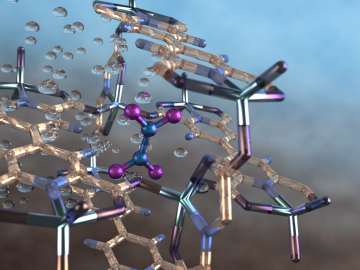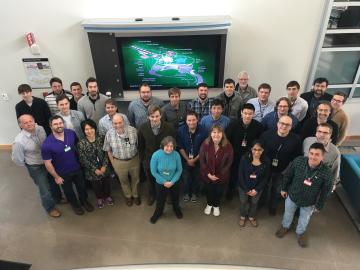
Filter News
Area of Research
- (-) Energy Science (37)
- (-) National Security (12)
- (-) Nuclear Science and Technology (7)
- Advanced Manufacturing (1)
- Biology and Environment (11)
- Computational Engineering (1)
- Computer Science (7)
- Electricity and Smart Grid (1)
- Fusion and Fission (2)
- Isotopes (9)
- Materials (40)
- Materials for Computing (4)
- Neutron Science (64)
- Quantum information Science (1)
- Sensors and Controls (1)
- Supercomputing (26)
News Type
News Topics
- (-) Artificial Intelligence (10)
- (-) Grid (25)
- (-) Isotopes (4)
- (-) Neutron Science (12)
- (-) Physics (3)
- 3-D Printing/Advanced Manufacturing (54)
- Advanced Reactors (9)
- Big Data (4)
- Bioenergy (17)
- Biology (8)
- Biomedical (6)
- Biotechnology (3)
- Buildings (21)
- Chemical Sciences (11)
- Clean Water (5)
- Composites (14)
- Computer Science (27)
- Coronavirus (7)
- Critical Materials (8)
- Cybersecurity (11)
- Energy Storage (47)
- Environment (30)
- Exascale Computing (2)
- Fossil Energy (1)
- Frontier (1)
- Fusion (4)
- High-Performance Computing (4)
- Hydropower (2)
- Machine Learning (9)
- Materials (29)
- Materials Science (22)
- Mathematics (1)
- Mercury (2)
- Microscopy (6)
- Molten Salt (4)
- Nanotechnology (6)
- National Security (12)
- Nuclear Energy (21)
- Partnerships (11)
- Polymers (10)
- Quantum Science (1)
- Security (7)
- Simulation (2)
- Space Exploration (5)
- Statistics (1)
- Summit (3)
- Transportation (45)
Media Contacts

To better determine the potential energy cost savings among connected homes, researchers at Oak Ridge National Laboratory developed a computer simulation to more accurately compare energy use on similar weather days.

An international team of scientists, led by the University of Manchester, has developed a metal-organic framework, or MOF, material

Using the Titan supercomputer and the Spallation Neutron Source at the Department of Energy’s Oak Ridge National Laboratory, scientists have created the most accurate 3D model yet of an intrinsically disordered protein, revealing the ensemble of its atomic-level structures.

IDEMIA Identity & Security USA has licensed an advanced optical array developed at Oak Ridge National Laboratory. The portable technology can be used to help identify individuals in challenging outdoor conditions.

Scientists at Oak Ridge National Laboratory have developed a low-cost, printed, flexible sensor that can wrap around power cables to precisely monitor electrical loads from household appliances to support grid operations.

Gleaning valuable data from social platforms such as Twitter—particularly to map out critical location information during emergencies— has become more effective and efficient thanks to Oak Ridge National Laboratory.

Scientists from Oak Ridge National Laboratory performed a corrosion test in a neutron radiation field to support the continued development of molten salt reactors.

Oak Ridge National Laboratory scientists have devised a method to control the heating and cooling systems of a large network of buildings for power grid stability—all while ensuring the comfort of occupants.

The Department of Energy’s Oak Ridge National Laboratory is now producing actinium-227 (Ac-227) to meet projected demand for a highly effective cancer drug through a 10-year contract between the U.S. DOE Isotope Program and Bayer.

After more than a year of operation at the Department of Energy’s (DOE’s) Oak Ridge National Laboratory (ORNL), the COHERENT experiment, using the world’s smallest neutrino detector, has found a big fingerprint of the elusive, electrically neutral particles that interact only weakly with matter.


